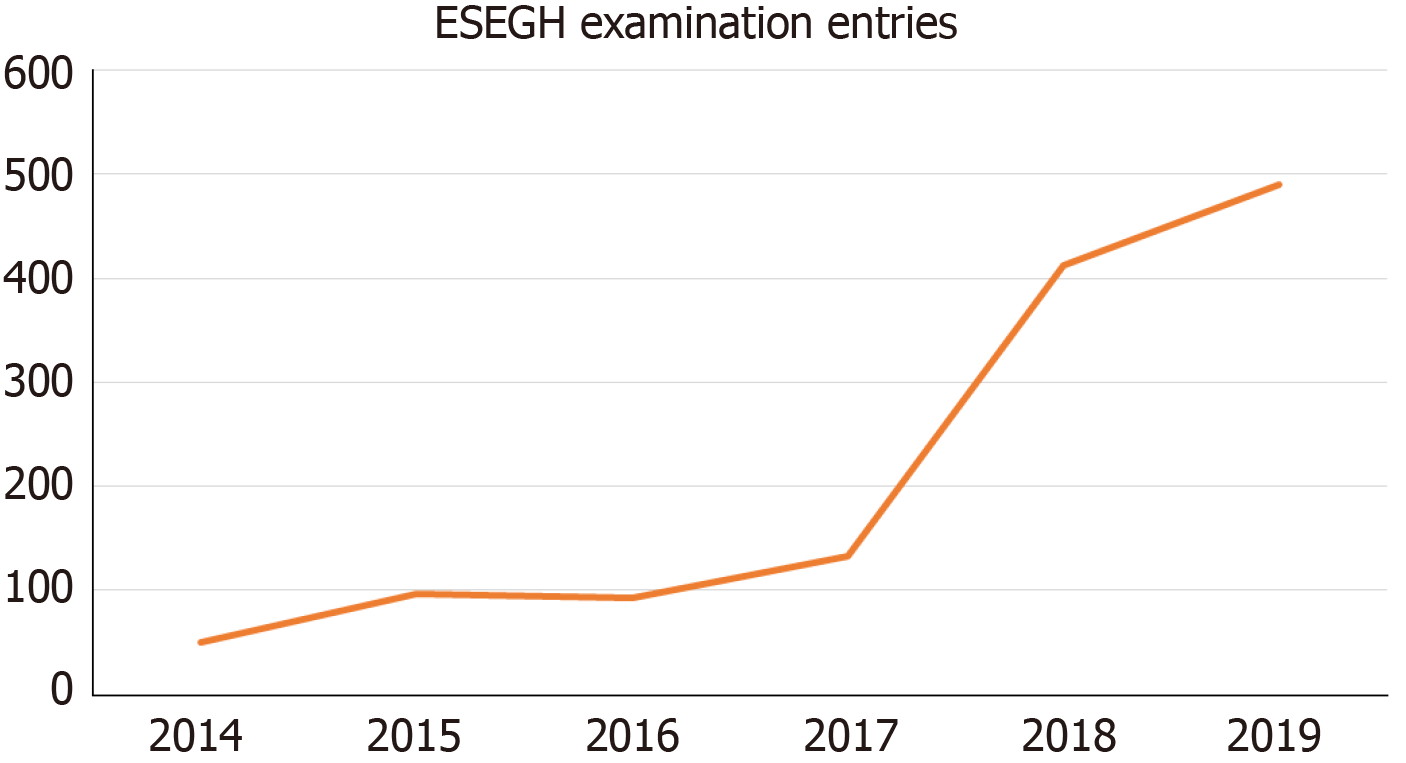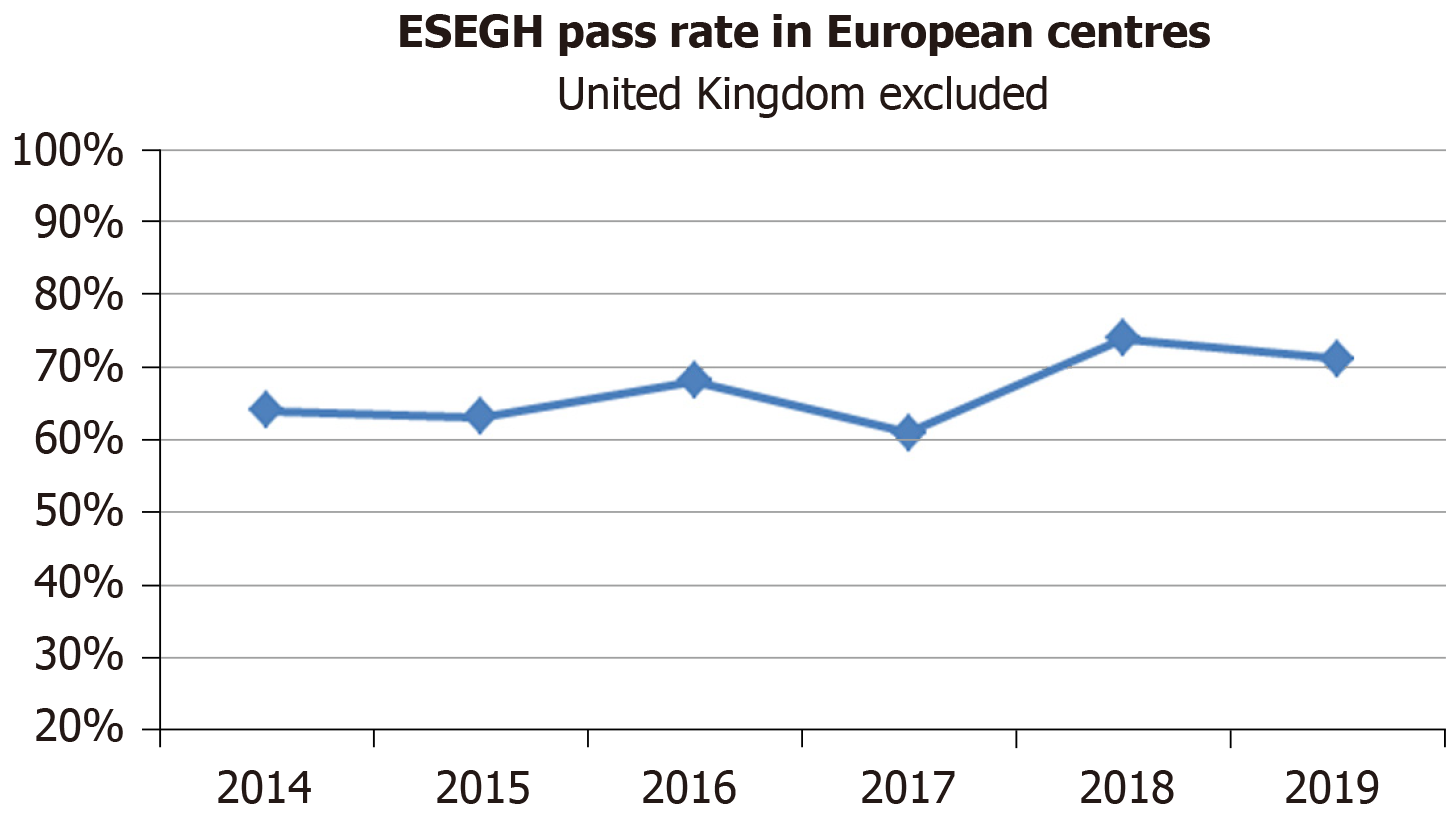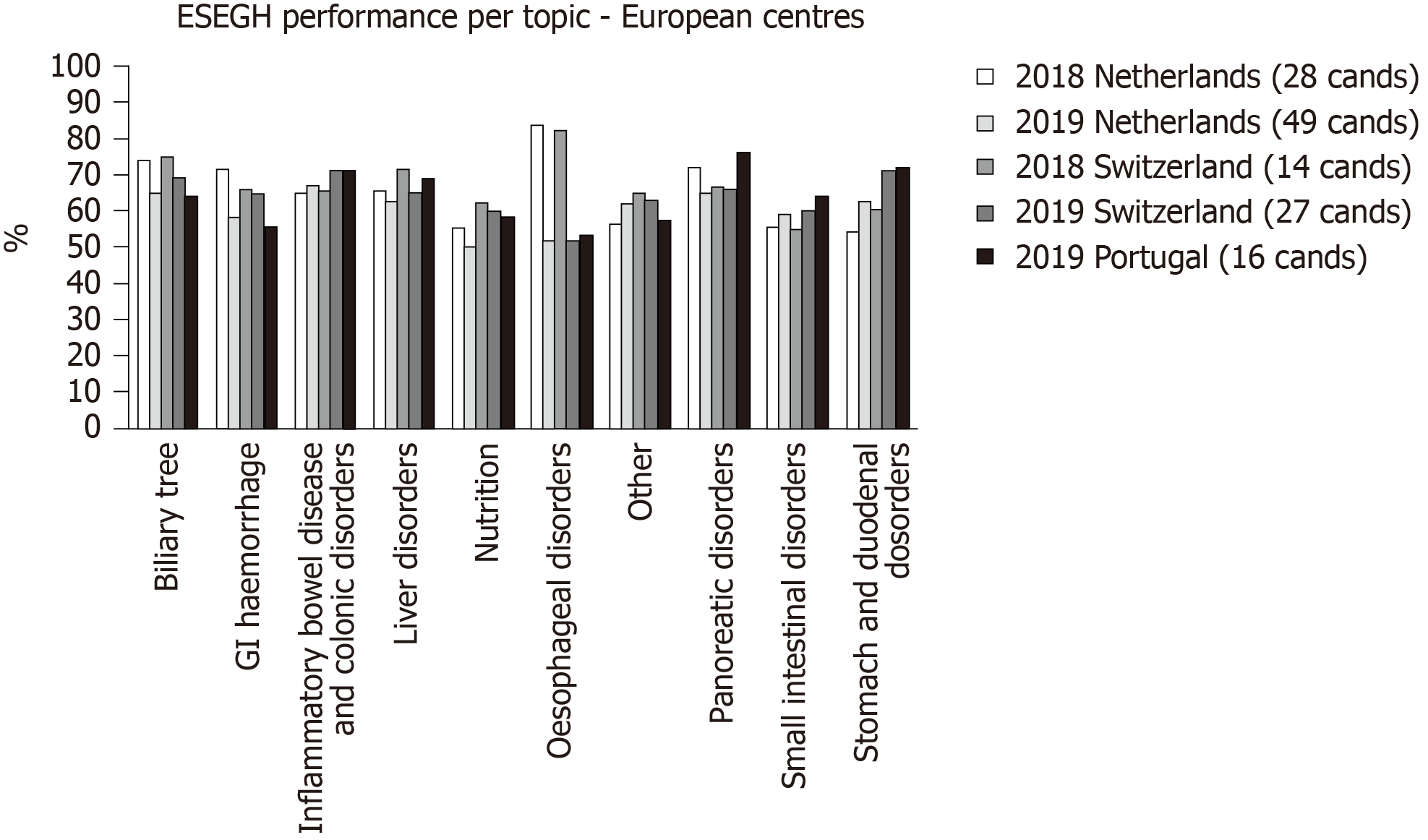Published online Apr 28, 2020. doi: 10.13105/wjma.v8.i2.41
Peer-review started: December 2, 2019
First decision: March 24, 2020
Revised: March 28, 2020
Accepted: April 15, 2020
Article in press: April 15, 2020
Published online: April 28, 2020
Processing time: 147 Days and 21.2 Hours
The Federation of Royal Colleges, the British Society of Gastroenterology (BSG) and the European Section and Board of Gastroenterology and Hepatology developed the European Specialty Examination in Gastroenterology and Hepatology (ESEGH) from the United Kingdom Specialty Certificate Examination, which was the original examination. Since 2018 the Specialty Certificate Examination and the ESEGH were combined into a single exam, identical across Europe and the rest of the world. The ESEGH is mandated in 4 countries (United Kingdom, Switzerland, The Netherlands and Malta) and the number of entries increased from 50 in 2014 to 490 in 2019. Candidates from countries were the ESEGH is not mandated are sitting the Exam, showing us they realize the enormous interest of holding a certificate for knowledge in their Curriculum. We also have an increasing number of candidates from countries outside Europe.
Core tip: The examination is one of the largest Physician Specialty Examination in Europe, and is a four-way cooperation between Union of European Medical Specialties, The European Board of Gastroenterology and Hepatology, the British Society of Gastroenterology and the Federation of Royal Colleges of the United Kingdom. The United Kingdom GMC formally approved the European Examination in January 2018. The European Specialty Examination in Gastroenterology and Hepatology is mandated in 4 European countries and the increasing number of candidates in countries were not mandated is a measure of success.
- Citation: Cremers I, Pisani A, Majerović M, Lillienau J, Michopoulos S, Wiencke K, Ellis T, Barrison I. European Specialty Examination in Gastroenterology and Hepatology examination — improving education in gastroenterology and hepatology. World J Meta-Anal 2020; 8(2): 41-47
- URL: https://www.wjgnet.com/2308-3840/full/v8/i2/41.htm
- DOI: https://dx.doi.org/10.13105/wjma.v8.i2.41
The European Specialty Examination in Gastroenterology and Hepatology (ESEGH) Examination was first introduced in 2014, as a pilot programme based on the United Kingdom Specialty Certificate Examination (SCE) that was established in 2007. The ESEGH was developed from the United Kingdom SCE as the original examination. In the first sitting there were 50 entries (32 from Europe) for the European exam. In 2018 the SCE and ESEGH were combined into a single exam which was identical across Europe, the United Kingdom and the rest of the world, and in 2019 there were 490 entries (156 from Europe) (Figure 1).
This substantial increase in entries is due to the examination being mandated for trainees in several European countries and a significant increase in International candidates. The examination is one of the largest Physician Specialty Examination in Europe, and is a four-way cooperation between Union of European Medical Specialties (UEMS), The European Board of Gastroenterology and Hepatology, the British Society of Gastroenterology and the Federation of Royal Colleges of the United Kingdom. The United Kingdom GMC formally approved the European Examination in January 2018.
This paper describes how the quality and the governance of the examination are managed and discusses plans for future improvements.
The ESEGH is a computer-based, multiple-choice single best answer test divided into two papers. Candidates are allowed three hours to answer each paper, each comprising 100 items. Each question presents a clinical scenario, with the results of some investigations and perhaps an image or scan, and tests medical knowledge and competency in diagnosis, investigation, management and prognosis. Candidates are asked to choose the best answer from five options. The test is taken on one day annually at independently operated assessment centres. These centres run in most countries.
There are no entry requirements for the examination.
European Union (EU) candidates are encouraged to take the examination towards the end of their specialist training.
The Blue Book, 2017, approved by the UEMS, defines the curriculum of Gastroenterology and Hepatology training for UEMS–affiliated countries. The curriculum, revised on a five yearly cycle, has a writing group composed of European Section and Board of Gastroenterology and Hepatology Examination (ESBGH) delegates and representatives from the United European Gastroenterology (UEG), European Association for the Study of the Liver and the European Junior Doctors committee.
Those recommended can be found in the website http://www.eubogh.org.
Candidates are encouraged to plan their study in advance. As the field of gastroenterology and hepatology is rather vast, the subject material to be covered can be quite large. For a typical full-time trainee, it is recommended to start 3-4 mo prior to the exam.
In order to help guide their studies, candidates are encouraged to explore both the ESBGH and the Membership of the Royal Colleges of Physicians websites as they host invaluable information pertaining to the training curriculum (Blue Book) as well as resources, statistics and advice.
There are many possible resources available, from books to guidelines to journals to online websites. Overall, guidelines are possibly the best source of information as they are up to date with newly published data. When choosing which guidelines to study, it is recommended to pick those that are internationally recognized since the examination is European and not affiliated to a specific country. The major European societies, (such as UEG, European Association for the Study of the Liver, and BSG), have excellent material that is invaluable for learning. These include short videos, previous presentations and online classroom courses. Candidates are also encouraged to find resources that contain radiology, pathology or histology images and to familiarize themselves with their interpretation. The Post-Graduate Teaching Programme organized by UEG has a three year rolling cycle covering all major topics in the Blue Book.
It is particularly important that candidates are familiar with the subject areas of Nutrition, Functional Bowel Disorders and Infectious Diseases affecting the gastrointestinal tract and liver, as these subjects are not universally covered in all European National Curricula.
The exam is in the format of “Single Best Answer” multiple choice questions (MCQs). As there is a technique to answering the questions, which involves focusing on the important points in the stem and reading the question well, candidates should try to practice as many MCQs as possible. Mock MCQs can be found in dedicated books, various websites that contain question banks and the Membership of the Royal Colleges of Physicians website. Practising MCQs will also give a good indication of the level of knowledge that is required and the level of English that is used.
The examination is computer based, held at a designated centre and hosted by Pearson VUE. Candidates can familiarize themselves with the navigation of the test using the following website: https://wsr.pearsonvue.com/demo/.
The ESEGH is based on 200 single best answer questions, chosen to cover all the training curriculum of gastroenterology and hepatology, according to the European Training program, (The Blue Book). The numbers of questions in each area of gastroenterology and Hepatology is defined by the exam “blueprint” (Table 1).
| Candidates are tested on a wide range of common and important disorders as set out in the syllabus of the curriculum | |
| The composition of the paper is as follows: | |
| Topic | Number of questions1 |
| Biliary tree | 16 |
| Gastrointestinal haemorrhage | 10 |
| Inflammatory bowel disease and colonic disorders | 40 |
| Liver disorders | 40 |
| Nutrition | 10 |
| Oesophageal disorders | 16 |
| Pancreatic disorders | 16 |
| Small intestinal disorders | 20 |
| Stomach and duodenal disorders | 20 |
| Other2 | 12 |
| Total | 200 |
The writing and choosing of these 200 questions is a multistep process involving three groups - the Question Writing Group, the Examining Board (EB) and the Standard Setting Group (SSG).
The members of these three groups are selected by the three examination partners. They are chosen according to their areas of expertise and are accredited members of the organizations who nominated them. Prior to working in the question writing and selection process, these experts undergo a mandatory training course arranged by the Federation of Royal Colleges.
The members of the Question Writing Group are tasked to submit 10-12 new questions each year, usually from their area of expertise. The format of these questions is strictly defined, in order to harmonize the writing style and question content. Negative questions, and questions where all, or none, of the options are correct, are not allowed.
The questions are edited at the Federation of Royal Colleges, following which there is an annual meeting, where all the questions are discussed by groups of question writers, to verify that they ask about areas of knowledge suitable for an examination whose aim is to certify that the passing candidate has achieved the knowledge necessary to fulfil the requirements of the ESBGH curriculum which is a Europe-wide description of the level expected of a specialist in Gastroenterology and Hepatology.
All questions are generated according to current international guidelines. Once the questions have been edited and accepted, they are stored in a question bank (which already includes around 2500 questions). If the questions are not accepted, they may go back to the author for revision or are simply rejected.
Following this process, the EB meets to decide which questions are selected for the next examination based on the examination blueprint. They review 70-80 questions (not of their authorship) and present them at the meeting, with a recommendation for accepting, review, send back for rewriting or rejection. Approximately 350 questions are reviewed at this meeting, in order to choose the final 200 for the exam.
This meeting is followed by the review of questions at the SSG, using the Angoff technique[1]. Here the group members evaluate the degree of difficulty of each question. Prior to the meeting each member rates all the questions regarding what percentage of just passing candidates should pass the specific question. At the SSG each question is discussed and the percentage re-evaluated. Again questions can be send back for rewriting or rejected. Within the group of examination there are between 30 and 40 question that have been used in previous exams for which data are available about their performance. These “anchor” questions are used to determine the performance of each cohort of candidates across different years.
The final group of 200 questions, will be compiled into 2 papers uploaded into the electronic delivery system, before a final review to ensure that they are correctly formatted and that the coded answers are correct, before being sat in the following year. After the examination has been sat, the “performance” of each question is reviewed in order to ensure that questions are fair. This final quality assurance step picks up questions where there is different clinical practise across countries, or where the evidence base or guidance has changed between development of the exam and the day it is taken. Such questions may be removed from the final mark. This usually occurs of 0-2 questions per year.
To produce a criterion-referenced pass mark, a mean score was calculated for each examiner. To calculate a final score for the paper, the mean of the examiners’ mean scores was calculated. The process results in a pass mark that is usually 60% (+/- 2%) for each exam[2].
The performance of all candidates is showed in Table 2. The performance of European candidates is presented in Figure 2. In Figure 3 we can see the results of 2 countries were the ESEGH is mandated and a third (Portugal) were trainees sat the ESEGH on a voluntary basis. In 2019 all trainees who finished their training that year sat the ESEGH.
| Diet | Pass mark | Pass rate United Kinfdom trainees | Pass rate European centres | Pass rate all candidates |
| 2019 | 59% (118/200) | 78.7% (111/141) | 71.2% (111/156) | 59.2% (290/490) |
| 20181 | 60% (120/200) | 83% (146/176) | 73.9% (65/88) | 67.3% (278/413) |
| 2017 | 61.3% (122/199) | 76.4% (110/144) | 60.9% (81/1331) | 59.1% (146/247) |
| 2016 | 60.8% (121/199) | 82% (100/122) | 68.1% (62/911) | 65% (147/226) |
| 2015 | 62% (124/200) | 72.5% (87/120) | 63.2% (60/951) | 55.4% (128/231) |
| 2014 | 62.24% (122/196) | 76.2% (80/105) | 64% (32/501) | 53.5% (106/198) |
The European Board Examination ran from 2014-2017, as a separate exam to the United Kingdom SCE, and the two merged into a single identical exam from 2018 onwards. Trainees have been mandated to take the examination in Switzerland since 2015, and the Netherlands since 2017. United Kingdom trainees, for whom the SCE had been the mandated exam since 2007, have been mandated to take the combined ESEGH since 2018. In Malta the ESEGH is also mandatory.
There have been rapid increases in the numbers of entries over the last two years, with a particular expansion of International candidates, notably from the Middle East and South Asia.
The examination fully complies with the CESMA criteria agreed by UEMS in 2015[3].
European postgraduate medical assessments will facilitate mobility of medical practitioners throughout the EU by assessing specialist knowledge at an agreed EU standard. Furthermore, European examinations will enable benchmarking of candidates against their European colleagues in other EU countries.
However, passing a European postgraduate medical assessment will not imply a licence to practise. It is only the National Certifying Authority (NCA) in each country that will be able to provide such a licence. Nevertheless, where full NCA recognition of a qualification applies, European postgraduate medical assessments may provide a means for the NCA to determine eligibility for a licence to practise.
As stated above, some countries have mandated passing of the examination, as a necessity to complete specialist training.
The main subject areas of the 200 questions have remained fairly constant since the examination’s introduction and reflect the European Curriculum as described in the Blue Book, with approximately 40% of the questions covering liver or inflammatory bowel disease.
During the 6-year tenure of the examination, candidates have persistently performed less successfully on questions covering nutrition and gastrointestinal haemorrhage. Informal discussions with National Training Programme leads concerning these findings suggest that nutrition is not taught in some institutions, and trainees have less exposure to the acute care of patients with gastrointestinal bleeding than existed previously.
Pass rates of candidates taking the examination in European Centres have risen to over 70% in the 6-year tenure of the examination, with consistently higher rates in those countries where the examination is mandated and in countries where most of the eligible trainees sit the examination. It appears that structured training towards the examination leads to higher pass rates.
Trainees in the younger age group, 30-34, have higher pass rates, presumably due to their being in active training programmes when sitting the examination. There are no gender differences in outcome of the examination.
Candidates in Europe and outside Europe are sitting the ESEGH in increasing numbers in countries where the ESEGH is not mandatory, as the examination is recognised as a benchmark of the knowledge of successful candidates.
The ESBGH hopes that more and more EU countries will mandate the examination for their trainees. Our cooperative work with National Associations and Scientific Societies supports the widespread adoption of the Blue Book as a reference European Curriculum for Gastroenterology and Hepatology and the next revision due in 2021, will integrate even further with the examination.
Manuscript source: Unsolicited manuscript
Specialty type: Medicine, research and experimental
Country/Territory of origin: Portugal
Peer-review report’s scientific quality classification
Grade A (Excellent): A
Grade B (Very good): 0
Grade C (Good): 0
Grade D (Fair): D, D
Grade E (Poor): 0
P-Reviewer: Caboclo JF, Coban M, Niu ZS S-Editor: Zhang L L-Editor: A E-Editor: Qi LL
| 1. | Norcini JJ. Setting standards on educational tests. Med Educ. 2003;37:464-469. [RCA] [PubMed] [DOI] [Full Text] [Cited by in Crossref: 204] [Cited by in RCA: 189] [Article Influence: 8.6] [Reference Citation Analysis (0)] |
| 2. | McKinley DW, Norcini JJ. How to set standards on performance-based examinations: AMEE Guide No. 85. Med Teach. 2014;36:97-110. [RCA] [PubMed] [DOI] [Full Text] [Cited by in Crossref: 50] [Cited by in RCA: 62] [Article Influence: 5.6] [Reference Citation Analysis (0)] |
| 3. | Mathysen DGP, Rouffet JB, Tenore A, Papalois V, Sparrow O, Goldik Z. UEMS-CESMA Guideline for the Organisation of European Postgraduate Medical Assessments. In: UEMS-CESMA Guideline. 2015.16. Available from: https://www.uems.eu/mediand-library/documents/adopted-documents/2015. |











